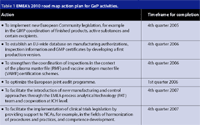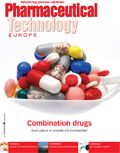The state of validation in the European Union
Pharmaceutical Technology Europe
Since the formation of the European Union (EU) in 1993, each member state has brought along its own regulatory baggage, namely the standards and regulations that their companies are formally required to comply with. These standards and regulations still apply for any pharmaceutical products a native manufacturer decides to market within their homeland. When the same manufacturer markets its pharmaceutical products to consumers in other EU member states, the regulatory directives of the European Commission and the European Agency for the Evaluation of Medicinal Products (EMEA) apply as well.
Since the formation of the European Union (EU) in 1993, each member state has brought along its own regulatory baggage, namely the standards and regulations that their companies are formally required to comply with. These standards and regulations still apply for any pharmaceutical products a native manufacturer decides to market within their homeland. When the same manufacturer markets its pharmaceutical products to consumers in other EU member states, the regulatory directives of the European Commission and the European Agency for the Evaluation of Medicinal Products (EMEA) apply as well.
If this manufacturer plans to export pharmaceutical products to international markets, corresponding regulatory requirements — such as those mandated by the US Food and Drug Administration (FDA) and the Japanese Ministry of Health, Labor, and Welfare (MHLW) — must also be considered. Additionally, global manufacturers must be aware of international guidelines, such as those imposed by the World Health Organization (WHO) and the International Society of Pharmaceutical Engineers (ISPE).
Luckily there is a global effort under way to make all of these regulatory bodies more consistent in their approach to pharmaceutical validation. The European Commission published The Rules Governing Medicinal Products in the European Union, Volume 4, concerning good manufacturing practice (GMP), which is consistent with FDA Good Manufacturing Practices for Finished Pharmaceuticals (21 CFR Parts 210 and 211).1,2
Both European Commission and FDA rules are consistent with the ISPE good automated manufacturing practice (GAMP), an internationally recognized validation guideline. The streamlining of these and other regulatory agency guidelines falls within the scope of the global GMP harmonization efforts brought about by the International Conference on Harmonization (ICH). This has also resulted in sweeping changes to Japan's pharmaceutical affairs law (PAL) to bring it in line with the GMP quality standards of the western world.
The overall intent is to make the process easier and more efficient for manufacturers to consistently produce pharmaceutical products that do not place patients at risk because of inadequate safety, quality, or efficacy by "establishing documented evidence that provides a high degree of assurance that a specific process will consistently produce a product meeting its predetermined specifications and quality characteristics."3 While many regulatory directives and regulations are intentionally vague regarding the specifics of how to conduct pharmaceutical validation, globally-accepted validation processes now seem to be pointing in a similar direction.
Validation pitfalls
The universal rule of thumb still applies: if a particular process or system has been validated previously with a given level of documentation and protocol testing, then it would be reasonable to assume that a comparable level of documentation and testing would be adequate to achieve compliant process validation for a similar manufacturing process or system.
However, this approach can be risky. As the FDA process validation guideline warns: "There is an inherent danger in relying on what are perceived to be similarities between products, processes, and equipment without appropriate challenge."3 The guideline goes on to say: "FDA recognizes that because of the great variety of medical products (drug products and medical devices), processes, and manufacturing facilities, it is not possible to state in one document all of the specific validation elements that are applicable."3 As a result, pharmaceutical companies and consulting firms contracted to help them perform process validation must refer to relevant experience, historical precedents, or other industry guidelines such as the GMP guidelines that apply for their intended markets.
Generally, each piece of equipment used in the manufacturing process — such as computer workstations, servers and controllers — must be qualified by performing and documenting applicable protocol testing. This ensures that the equipment is installed correctly (installation qualification [IQ]), is operating proficiently (operational qualification [OQ]), and is performing satisfactorily according to the required parameters of the overall system (performance qualification [PQ]).
Process validation of a manufacturing system, therefore, requires an entire suite of documents, typically including:
- A validation plan, which is a written plan stating how the process validation will be conducted, what documents will be included and how they will be approved.
- Functional requirements specifications that cover the technical aspects of the system.
- A risk assessment that considers inherent risks of the process and potential contingency plans.
- Executed IQ, OQ and PQ protocols, traceable to the functional requirements.
- Validation summary reports stating whether the system is fit to manufacture the product by summarizing results of validation testing and signifying that all required approval signatures have been obtained.4
Collectively, the process validation documentation must prove to a regulatory investigator that the company has built a system that will reliably produce the specified product with the required level of quality.
Once a process is validated, the pharmaceutical manufacturer must show that adequate controls are in place so that the validated state is maintained. European Commission directive 2003/94/EC states: "Principles and guidelines of good manufacturing practice should be set out in relation to quality management, personnel, premises and equipment, documentation, production, quality control, contracting out, complaints and product recall, and self-inspection."5
The EU GMP guideline goes on to say: "Regular periodic or rolling quality reviews of all licensed medicinal products, including export only products, should be conducted with the objective of verifying the consistency of the existing process, the appropriateness of current specifications for both starting materials and finished product to highlight any trends and to identify product and process improvements. Such reviews should normally be conducted and documented annually."6
Regulatory agencies for individual EU member states inspect pharmaceutical manufacturing facilities on a regular basis (e.g., the UK's Medicines Control Agency [MCA] inspects each facility on a two-yearly basis, irrespective of size) to ensure sustained GMP compliance and,
more often, if specific problems are suspected.7 Although inspection results can lead to strongly-worded warning letters, recommendations to revoke a license, and the possibility of prosecution, the overall intent is to promote public safety. As the EMEA emphasizes: "The key aspect of the [Agency's] vision for the coming years is to further strengthen the protection and promotion of public and animal health in the EU, whilst encouraging and facilitating innovation and research in an enlarged EU."8
Challenges or opportunities?
In Road Map to 2010: Preparing the Ground for the Future, EMEA readily admits that the future holds many new challenges resulting from a changing regulatory environment in terms of legislative, institutional and scientific developments. "Amongst them are political factors such as the continuation of the EU enlargement with Bulgaria and Romania joining in 2007 and other countries such as Turkey also seeking membership."8,9 Other issues cited by EMEA to be addressed in coming years include
- The fall in innovative productivity, despite a sharp increase in global R&D expenditure.
- Preparing adequately for the introduction of new technologies, from a scientific, legal and regulatory perspective.
- Taking advantage of new pharmaceutical technologies in the manufacturing and analytical areas, and anticipating the implications of emerging therapies.
There is also a need to adapt to changing health trends such as the impact of an ageing population; the increased demands for medicines in areas of unmet medical need; the possible unavailability of medicines in both the human and veterinary field; the ever-increasing concerns about the development of antimicrobial resistances; the adequate management of bioterrorism and chemical terrorism agents and other major public health issues (such as an influenza pandemic, another SARS outbreak)."8
The EMEA concludes: "These changes are not to be regarded as pure challenges, but rather as new opportunities which, through adequate proactive initiatives, should lead to an enhanced protection and promotion of public and animal health in an enlarged EU."8
The EMEA goes on to contend that each of the future challenges should be increasingly handled in a context of continuing globalization, as stated in the road map: "Faced with these challenges, the EMEA will have to demonstrate that the networking model on which it is based, involving institutional partners, 42 or more national competent authorities (NCAs) and over 3500 scientific experts, is still able to deliver high quality in the areas it is responsible for. In addition, there is a need for greater collaboration with — and for benchmarking against — non-EU regulatory authorities."8
In the area of regulatory compliance (e.g., GxP — good clinical practices, good laboratory practices, good manufacturing practices), the EMEA has plotted the following critical paths in its road map (Table 1).8

Table 1 EMEAôs 2010 road map action plan for GxP activities.
- Effective coordination of GxP inspections performed by the NCAs, particularly those undertaken in non-EU countries, to cover inspections in the framework of centralized licensed medicines with a strong link to decentralized licensed medicines to avoid duplication of work.
- Ensuring an appropriate quality assurance (QA) system through the work of the joint audit programme for appropriately trained EU GMP inspectorates.
- Introducing an EU-wide database on manufacturing authorizations, inspection information and GMP certificates to provide better information to regulators, while promoting the best use of community resources and avoiding duplication.
- Supporting its initiatives through contributions to international discussions on risk management from a quality perspective and through its cooperation with the WHO in relation to regulatory information provided to non-EU countries.
Constant compliance
In the EU, with 456 million people, pharmaceutical manufacturers should strive to maintain a constant state of regulatory compliance by incorporating a company-wide quality system as defined in the relevant GMP guidelines; making all employees aware of the quality system requirements through readily-accessible and open communication channels; and regularly training employees on all regulatory directives, regulations and GMP guidelines that pertain to their areas of accountability.
In addition, pharmaceutical manufacturers may proactively seek the extra guidance obtained through the voluntary use of a third-party quality management system (QMS), such as ISO 9000 or lean six sigma. Combining these efforts and open communication channels with EMEA and local NCA regulatory offices helps to set a favourable climate in trying to maintain a successfully compliant manufacturing environment.
Doug Bonanomi is a consultant at Stelex Inc (USA).
References
1. http://pharmacos.eudra.org
2. www.fda.gov
3. FDA Guideline on General Principles of Process Validation, 1987 (US Food and Drug Administration, 5600 Fishers Lane, Rockville MD 20857-0001, USA).
4. D. Bonanomi, Pharm. Technol. 28(2), 98–102 (2004).
5. European Commission, Commission Directive 2003/94/EC, 8 October 2003 (EMEA, 7 Westferry Circus, Canary Wharf, London, UK).
6. European Commission, Eudralex, The Rules Governing Medicinal Products in the European Union, Volume 4, EU Guidelines to Good Manufacturing Practice, Medicinal Products for Human and Veterinary Use, Part I, Chapter 1, 2005 EMEA, 7 Westferry Circus, Canary Wharf, London, UK).
7. D. Simpson, The Pharmaceutical Journal, 266 (1731), 85–88 (2001).
8. EMEA, The European Medicines Agency Road Map to 2010: Preparing the Ground for the Future, 2005 EMEA, 7 Westferry Circus, Canary Wharf, London, UK).

Drug Solutions Podcast: A Closer Look at mRNA in Oncology and Vaccines
April 30th 2024In this episode fo the Drug Solutions Podcast, etherna’s vice-president of Technology and Innovation, Stefaan De Koker, discusses the merits and challenges of using mRNA as the foundation for therapeutics in oncology as well as for vaccines.